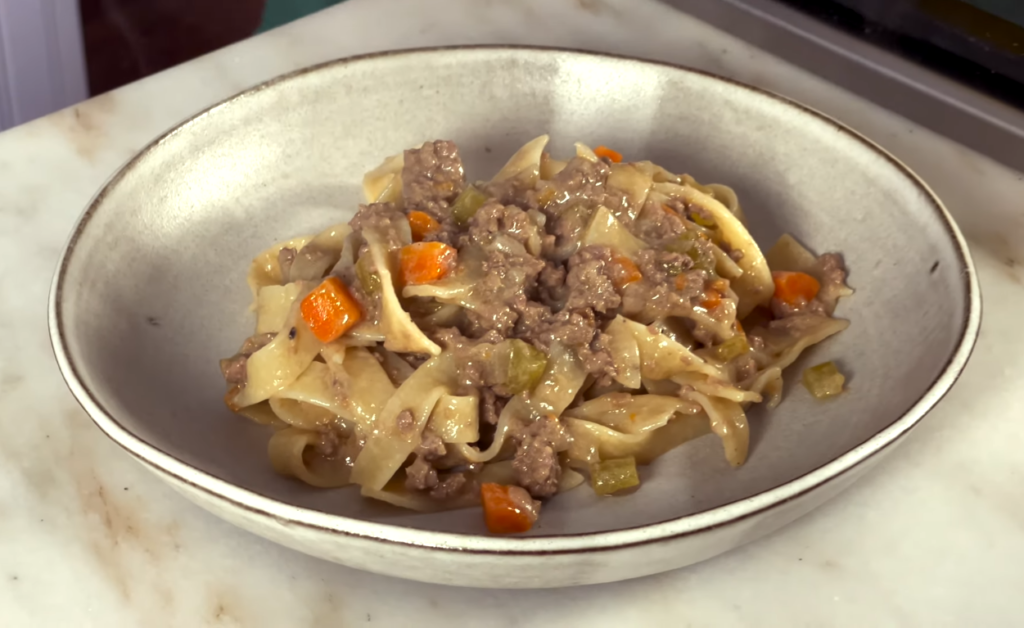Bison Ragu
Bison is a nutritious meat choice, rich in vitamin B12, zinc, iron, selenium, and omega-3 fatty acids, while being lower in saturated fats compared to beef. Choosing bison ragu from sustainable sources like Force of Nature is also beneficial for the environment. One of the best ways to prepare tougher cuts of meat, like bison, is by braising them, which helps tenderize and infuse flavor. This method is similar to my recipes for Not-so-secret Bolognese and Italian Short Ribs with Gnocchi.
The bison ragu recipe is versatile and can be adapted to use other meats such as lamb, elk, beef, or sausage. For those short on time, there’s also a quicker option with my Quick Lamb Ragu recipe. This flexibility allows you to enjoy a delicious, hearty dish regardless of the meat you choose.
Ingredients of Bison Ragu
- Ground Bison: 1 lb
- Chopped Pancetta: ¼ lb
- Rigatoni or Other Pasta: 1 lb
- Whole Plum Tomatoes (canned): 1 can (28 oz)
- Red Wine: 1 cup
- Chopped Carrots: ¾ cup (about 2 carrots)
- Chopped Celery: ¾ cup (about 2 celery stalks)
- Chopped Onion: 1 cup (about one medium onion)
- Garlic (minced): 4 cloves
- Tomato Paste: 2 tbsp
- Extra Virgin Olive Oil (EVOO): 2 tbsp
- Basil: 1 handful (fresh

Procedure to Make Bison Ragu.
1. Cook the Pancetta and Vegetables
Start by heating a large saucepan or Dutch oven over medium heat. Add the chopped pancetta and cook it until it’s golden brown and crispy, stirring frequently to ensure even cooking. Once browned, use a slotted spoon to remove the pancetta from the pot, leaving behind the rendered fat. Add 2 tablespoons of extra virgin olive oil (EVOO) to the pot. Next, add the chopped onion, celery, and carrots, along with a pinch of salt. Sauté the vegetables until they soften and the onions turn translucent. Finally, stir in the minced garlic and sauté for an additional 2 minutes.
2. Brown the Bison
Add the ground bison directly into the pot with the sautéed vegetables. Use a spoon to break the bison into smaller pieces, and sprinkle a pinch of salt over it. Cook the bison until it’s just browned, stirring often. It’s normal for some liquid to accumulate in the pot; continue stirring until this liquid evaporates. Once browned, stir in the tomato paste and let it cook for 2-3 minutes to caramelize and enhance the flavor.
3. Deglaze with Red Wine
Pour in 1 cup of red wine, scraping up any browned bits stuck to the bottom of the pot. Bring the mixture to a simmer and let it cook until the wine is almost completely absorbed, which should take about 6-8 minutes. This step adds depth and richness to the ragu.
4. Add the Tomatoes and Simmer
Using your hands or an immersion blender, crush the whole plum tomatoes in their can. Pour the crushed tomatoes into the sauce and stir to combine. Return the sauce to a simmer, then add the reserved pancetta, a handful of fresh basil, and another pinch of salt. Allow the sauce to simmer on low heat for 2-3 hours, slightly covered. This slow cooking allows the flavors to meld beautifully.
5. Monitor the Sauce
As the ragu simmers, check on it every 15 minutes. If the sauce begins to dry out, add a bit of water to maintain the right consistency. Stir occasionally to prevent the bottom from burning and ensure even cooking.
6. Cook the Pasta
While the ragu is simmering, bring a large pot of water to a boil. Add salt to the water and cook the pasta according to package instructions until it’s al dente. Reserve ½ cup of the pasta cooking water before draining the pasta.
7. Combine and Serve
Once the pasta is cooked, add the reserved pasta water to the ragu and stir well. Then, add the drained pasta to the sauce and toss until everything is well combined. Serve the bison ragu hot, topped with freshly grated pecorino romano cheese, and pair it with a crusty loaf of Italian bread for a complete meal.
FAQs for Bison Ragu
What kind of meat can I use instead of bison?
You can substitute ground bison with other meats like lamb, elk, beef, or sausage. Each will provide a unique flavor profile.
Can I use a different type of tomato?
Yes, you can replace whole plum tomatoes with crushed or sieved tomatoes if preferred. Whole tomatoes are used for their texture and flavor.
What type of pasta works best?
Rigatoni is recommended, but you can use any pasta shape you like. Just ensure it can hold the ragu well.
How long does the ragu need to simmer?
The ragu should simmer for 2-3 hours on low heat for the best flavor development. Stir occasionally to prevent sticking.
What kind of red wine should I use?
Use a decent dry red wine. Avoid cheap wines as their flavors will affect the final dish.
Can I prepare this ragu in advance?
Yes, you can make it a day ahead. The flavors will deepen after sitting in the fridge. Just reheat before serving.
How can I reheat leftover ragu?
Reheat in a small saucepan over medium heat. Add a bit of water and EVOO to loosen the sauce if it’s too thick.
Is this recipe suitable for freezing?
Yes, you can freeze the ragu. Store it in an airtight container for up to 3 months. Thaw and reheat when ready to use.
What can I serve with bison ragu?
Serve it over pasta, and complement with grated pecorino romano cheese and a side of crusty Italian bread.
How many servings does this recipe yield?
The recipe makes approximately 5 servings, depending on portion sizes.
